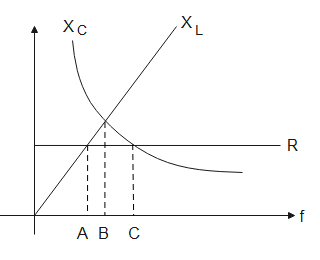
Figure shows variation of $R$, ${{X}_{L}}$ and ${{X}_{C}}$ with frequency $f$ in a series LCR circuit. Then for what frequency point the circuit is inductive?

(1). A
(2). B
(3). C
(4). all points

Answer
542.7k+ views
Hint: An AC circuit consisting of a capacitor, inductor and resistor connected together is known as LCR circuit. Ohm’s law can be applied to this circuit. The reactance in the circuit depends on the inductive reactance, capacitive reactance and resistance. In an inductive circuit, the inductance reactance is more than the capacitive reactance.
Complete answer:
An L, C, R circuit is a circuit which contains a capacitor, an inductor and a resistance connected together. The total reactance in the circuit is given by-
$Z=\sqrt{{{R}^{2}}+{{({{X}_{L}}-{{X}_{C}})}^{2}}}$
Here, $Z$ is the total reactance in the circuit
$R$ is the resistance
${{X}_{L}}$ is the inductive reactance
${{X}_{C}}$ is the capacitive reactance
A circuit is known as an inductive circuit when the value of inductance in the circuit is more than the value of capacitance. The value of inductance increases after resonance frequency is attained.
The resonance in a circuit is achieved when the inductive reactance and the capacitive reactance are equal to each other. Therefore,
${{X}_{L}}={{X}_{C}}$

In the graph, at the point C, ${{X}_{L}}$ is greater than ${{X}_{C}}$ because this is the point after the resonance condition is attained.
Therefore, the circuit is inductive at point C in the graph.
Hence, the correct option is (3).
Note:
AC current flows in a LCR circuit. During resonance, the current is the circuit suddenly increases to its highest value as the reactance in the circuit is minimum. A capacitor stores charge on it while an inductor opposes the change in the magnitude or direction of current in the circuit. The resonant frequency of a circuit depends on the value of inductance and capacitance in the circuit.
Complete answer:
An L, C, R circuit is a circuit which contains a capacitor, an inductor and a resistance connected together. The total reactance in the circuit is given by-
$Z=\sqrt{{{R}^{2}}+{{({{X}_{L}}-{{X}_{C}})}^{2}}}$
Here, $Z$ is the total reactance in the circuit
$R$ is the resistance
${{X}_{L}}$ is the inductive reactance
${{X}_{C}}$ is the capacitive reactance
A circuit is known as an inductive circuit when the value of inductance in the circuit is more than the value of capacitance. The value of inductance increases after resonance frequency is attained.
The resonance in a circuit is achieved when the inductive reactance and the capacitive reactance are equal to each other. Therefore,
${{X}_{L}}={{X}_{C}}$

In the graph, at the point C, ${{X}_{L}}$ is greater than ${{X}_{C}}$ because this is the point after the resonance condition is attained.
Therefore, the circuit is inductive at point C in the graph.
Hence, the correct option is (3).
Note:
AC current flows in a LCR circuit. During resonance, the current is the circuit suddenly increases to its highest value as the reactance in the circuit is minimum. A capacitor stores charge on it while an inductor opposes the change in the magnitude or direction of current in the circuit. The resonant frequency of a circuit depends on the value of inductance and capacitance in the circuit.
Recently Updated Pages
Master Class 12 English: Engaging Questions & Answers for Success

Master Class 12 Business Studies: Engaging Questions & Answers for Success

Master Class 12 Economics: Engaging Questions & Answers for Success

Master Class 12 Social Science: Engaging Questions & Answers for Success

Master Class 12 Maths: Engaging Questions & Answers for Success

Master Class 12 Chemistry: Engaging Questions & Answers for Success

Trending doubts
What are the major means of transport Explain each class 12 social science CBSE

Which are the Top 10 Largest Countries of the World?

Draw a labelled sketch of the human eye class 12 physics CBSE

Explain sex determination in humans with line diag class 12 biology CBSE

The pH of the pancreatic juice is A 64 B 86 C 120 D class 12 biology CBSE

Explain sex determination in humans with the help of class 12 biology CBSE




